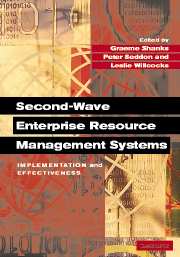Book contents
- Frontmatter
- Contents
- List of Contributors
- Introduction: ERP – The Quiet Revolution?
- Part I Implementation and Effectiveness: Overview
- Part II From Risks to Critical Success Factors
- Part III From Learning to Knowledge
- 10 Implementing Enterprise Resource Planning Systems: The Role of Learning from Failure
- 11 ERP Projects: Good or Bad for SMEs?
- 12 The Role of the CIO and IT Functions in ERP
- 13 Enterprise System Management with Reference Process Models
- 14 An ERP Implementation Case Study from a Knowledge Transfer Perspective
- 15 Knowledge Integration Processes within the Context of Enterprise Resource Planning System Implementation
- Part IV Cultural Aspects of Enterprise Systems
- Part V Future Directions
- Index
- References
12 - The Role of the CIO and IT Functions in ERP
from Part III - From Learning to Knowledge
Published online by Cambridge University Press: 05 February 2012
- Frontmatter
- Contents
- List of Contributors
- Introduction: ERP – The Quiet Revolution?
- Part I Implementation and Effectiveness: Overview
- Part II From Risks to Critical Success Factors
- Part III From Learning to Knowledge
- 10 Implementing Enterprise Resource Planning Systems: The Role of Learning from Failure
- 11 ERP Projects: Good or Bad for SMEs?
- 12 The Role of the CIO and IT Functions in ERP
- 13 Enterprise System Management with Reference Process Models
- 14 An ERP Implementation Case Study from a Knowledge Transfer Perspective
- 15 Knowledge Integration Processes within the Context of Enterprise Resource Planning System Implementation
- Part IV Cultural Aspects of Enterprise Systems
- Part V Future Directions
- Index
- References
Summary
Introduction
By 1999 the ERP ‘revolution’ was generating over $US20 billion revenues annually for suppliers and a further $20 billion to consulting firms. If 2000 and 2001 saw a fall-off in business globally, then some believed that once the distractions of Y2K deadlines were over, new ERP business plus the need to support and capitalise on the sunk investment in IT infrastructure ERP already represented would guarantee further take-off. Once again, at first without many noticing, information technology (IT) not only raised itself high above the cost parapet, but also set off traditional alarm bells about questionable business value. For many firms ERP represents the return of the old IT catch 22 with a vengeance – competitively and technically it is a ‘must-do’, but economically there is conflicting evidence, suggesting it is difficult to cost justify, and difficult to derive benefits from.
The problem has been further complicated by the coming of web-based technologies. Thus Sauer and Willcocks (2001) found many organizations struggling to integrate their legacy and relatively new ERP systems with e-business initiatives and technologies. The goal of a relatively seamless e-business infrastructure seemed particularly difficult to achieve in ‘bricks and mortar’ companies trying to move to the web (Sauer and Willcocks, 2000), a finding explained by Kanter (2001) and Willcocks and Sauer (2000) in terms of cultural, organizational, and political issues, together with less than good organization and project management for e-business.
- Type
- Chapter
- Information
- Second-Wave Enterprise Resource Planning SystemsImplementing for Effectiveness, pp. 299 - 314Publisher: Cambridge University PressPrint publication year: 2003
References
- 2
- Cited by



